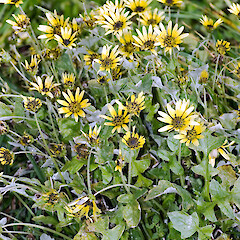Arctotheca calendula
Common name
Cape weed
Family
Asteraceae
Flora category
Vascular – Exotic
Structural class
Herbs - Dicotyledonous composites
NVS code
The National Vegetation Survey (NVS) Databank is a physical archive and electronic databank containing records of over 94,000 vegetation survey plots - including data from over 19,000 permanent plots. NVS maintains a standard set of species code abbreviations that correspond to standard scientific plant names from the Ngä Tipu o Aotearoa - New Zealand Plants database.
ARCCAL
Conservation status
Not applicable
Habitat
Terrestrial. Coastal situations especially sand dunes.
Detailed description
Annual rosette herb with sprawling stems rarely reaching 30 cm. The leaves are lobed up to 30 x 5 cm and held on somewhat branched and leafy stems. Flower heads are solitary and are approximately 3.5 cm across with a black disc and yellow rays.
Similar taxa
May be confused with closely related Gazania rigens and G. linearis these also have yellow flowers, but A. calenmdula has lobed leaves and the stems lack the latex contained in Gazania species. May also be confused with Arctotis stoechadifolia, but this species has purple florets on the flowers.
Flowering
October, November, December
Flower colours
Black, Yellow
Fruiting
October, November, December, January, February, March, April
Year naturalised
1870
Origin
South Africa
Etymology
calendula: From the Latin word kalendae, first day of the month when interest was paid; refers to the plant’s long flowering season.
Reason For Introduction
Accidental
Life Cycle
Annual, producing prolific amounts of seed that are dispersed by people, wind, sand movement.
ToleranceS
Can tolerate salt and poor soils in coastal situations.










